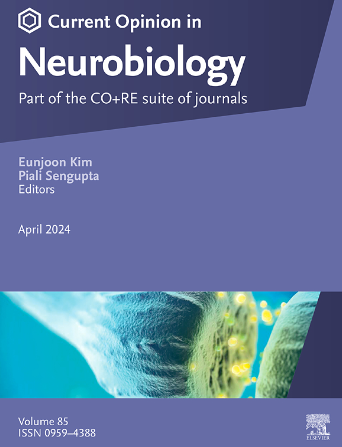TMC1 and TMC2 function as the mechano-electrical transduction ion channel in hearing
IF 5.2
2区 医学
Q1 NEUROSCIENCES
引用次数: 0
Abstract
Mechanotransduction within the specialized cochlea hair cells is fundamental to perceiving sound waves. This intricate mechanism converts mechanical vibrations into electrical signals that the brain can interpret as sound. The molecular identity of the mechanoelectrical transducer continues to be a subject of intense debate. Transmembrane channel-like protein 1 (TMC1) was initially recognized as a deafness gene in humans, with subsequent studies revealing the hearing loss phenotype in Tmc1 mutant mice. Mechanotransduction currents were lost in the hair cells of Tmc1;Tmc2 double knockout mice, indicating the involvement of TMC1/2 in auditory mechanotransduction. Both TMC1/2 are expressed at the tip of stereocilia in hair cells, the subcellular site of auditory mechanotransduction. Notably, recent in vitro studies have overcome long-standing technical barriers that TMC1/2 are not localized to the cell membrane in heterologous expression and provided compelling evidence that TMC1/2 are mechanically gated ion channels, finally fulfilling both the essential and necessary criteria they must meet as sensory transducers. In hair cells, tip-links possibly relay force to TMC1/2 by tether gating or membrane-tension gating, while the molecular mechanisms underlying each gating mechanism require further investigation.
TMC1和TMC2在听力中起机电转导离子通道的作用
特化耳蜗毛细胞内的机械传导是感知声波的基础。这种复杂的机制将机械振动转化为电信号,大脑可将其解读为声音。机电转换器的分子特征仍然是一个激烈争论的话题。跨膜通道样蛋白 1(TMC1)最初被认为是人类的耳聋基因,随后的研究揭示了 Tmc1 突变小鼠的听力损失表型。Tmc1;Tmc2 双基因敲除小鼠的毛细胞中失去了机械传导电流,这表明 TMC1/2 参与了听觉机械传导。TMC1/2均表达于听觉机械传导的亚细胞部位--毛细胞的立体纤毛顶端。值得注意的是,最近的体外研究克服了长期以来 TMC1/2 在异源表达时不定位在细胞膜上的技术障碍,并提供了令人信服的证据,证明 TMC1/2 是机械门控离子通道,最终满足了它们作为感觉传导器必须满足的基本和必要标准。在毛细胞中,尖端连接可能通过系链门控或膜张力门控将力传递给 TMC1/2,而每种门控机制的分子机制还需要进一步研究。
本文章由计算机程序翻译,如有差异,请以英文原文为准。
求助全文
约1分钟内获得全文
求助全文
来源期刊

Current Opinion in Neurobiology
医学-神经科学
CiteScore
11.10
自引率
1.80%
发文量
130
审稿时长
4-8 weeks
期刊介绍:
Current Opinion in Neurobiology publishes short annotated reviews by leading experts on recent developments in the field of neurobiology. These experts write short reviews describing recent discoveries in this field (in the past 2-5 years), as well as highlighting select individual papers of particular significance.
The journal is thus an important resource allowing researchers and educators to quickly gain an overview and rich understanding of complex and current issues in the field of Neurobiology. The journal takes a unique and valuable approach in focusing each special issue around a topic of scientific and/or societal interest, and then bringing together leading international experts studying that topic, embracing diverse methodologies and perspectives.
Journal Content: The journal consists of 6 issues per year, covering 8 recurring topics every other year in the following categories:
-Neurobiology of Disease-
Neurobiology of Behavior-
Cellular Neuroscience-
Systems Neuroscience-
Developmental Neuroscience-
Neurobiology of Learning and Plasticity-
Molecular Neuroscience-
Computational Neuroscience
 求助内容:
求助内容: 应助结果提醒方式:
应助结果提醒方式:


